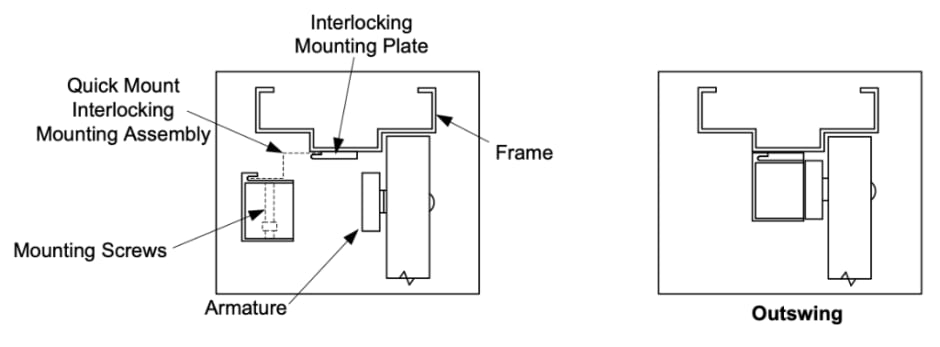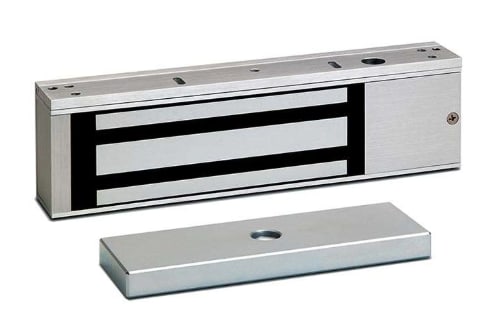If you’re looking to secure your door with something more modern than a traditional deadbolt or lock and key mechanism, you might want to explore various magnetic and electric lock options. They come in a variety of shapes and sizes, each specialized for a different use case and door configuration. Kisi actually has a guide that offers an overview of the different kinds of locks out there, and which might be right for you. In this article, we’ll dive into the magnetic lock technology, offer some installation tips, and some guidance for day-to-day use.
How a Magnetic Lock Works
In this section we’ll explore the tech behind a magnetic lock and go through its installation procedures.
The “Moving Parts” of a Magnetic Lock
Magnetic locks, or maglocks, are comprised of two main parts, a mounting mechanism, and some wires. The two parts are installed on the frame and the door, so that their magnetic sides are facing each other. The mounting plate can be installed in case your door frame or door doesn’t allow direct mounting. The wires are then connected to the lock to provide electricity to power the magnet, and are run either along or through the walls to a dedicated power supply.

Fail-Safe Mechanism
Maglocks operate on a fail-safe mechanism. This means that when power is supplied to the lock, the magnet is activated, and the two halves (one screwed onto the wall and one onto the door) are stuck together, keeping the door locked. When the lock is triggered, power is cut and the door unlocks.

Fail-safe locks are ideal for emergency routes, because in case of an emergency it’s more likely that the power will be out. In those cases you want to be able to open the door. That’s why many businesses opt to install a magnetic lock on their front doors.
How to Install It
When installing a magnetic lock, you will need to drill holes in the wall and the door to screw in the lock itself, and run wires through the wall to connect it to a permanent power source .
In terms of actual installation instructions, we recommend our maglock installation video. We generally recommend the Schlage 400 series maglock as a good all-around lock, and you can find detailed installation diagrams at this page for all configurations. In general, they all follow the same format: You drill the holes, mount the brackets to hold the locks, run the wires, power it up, and then test it out.
How to Test It
Testing the lock is a pretty important part of any installation process. Whether you’re brave enough to do it yourself, or you have an installer come by to set it up for you, you can’t truly consider the lock installed until you’ve given it a test drive, and checked to make sure that it unlocks properly.
The way to do this is relatively straightforward. You’ll have to connect the power, at which point you actually test the lock’s unlocking capabilities with whatever access system you have at hand. When the lock is powered, it should hold the door closed tightly, and when the power is cut, the lock should open.
What to Look out For
There are a few factors that you should be on the lookout for in this sort of installation, beyond just proper functioning. The first of these is fire compliance: Different cities and building types have different fire codes, and you may be required to install a sort of motion sensor or contact sensor or request-to-exit button. For more information on fire codes and fire security, check out the article on this site.
On the same topic of emergency situations, you may want a manual override key in your door. Despite the fact that this is a fail-safe lock, meaning that you can exit even if the power goes out, there might be some sort of malfunction inside the lock which prevents opening at a crucial time. In this instance, a back-up key would be useful. You should consult with your installer or integrator about this.
Learn more about magnetic locks and access control
Download our physical security guide.
How is a magnetic lock unlocked using an access control system?
In this section we’ll provide a basic overview of how these magnetic locks work with modern IP-based access control.
Wiring
In the same way magnetic locks need to be powered with electricity, they also need to be wired to the access controller to know when it’s being prompted to open. As mentioned with the fail-safe nature of these locks, when they are triggered they cut their power to unlock. So when the access control readers send an impulse to the lock, the power will be temporarily cut (the length of time can be programmed), and the door will open.

Here is a sample diagram of how Kisi readers and controllers are wired to a magnetic lock. There is a dedicated lock power supply, and a separate power supply for the controller. The controller is connected to both the lock and the lock power supply, so that it can cut off the power when it judges that the door should be unlocked.
Unlocking
As with wiring, and most other things related to these locks, unlocking will depend on the method of access that you choose. If the wiring is set up correctly, and you’re using a modern IP-based access control system like Kisi, then unlocking your door will be as simple as tapping your phone (or a keycard) to the reader next to your door.
At that point, the reader will send a Bluetooth or Wifi signal to the controller, the brains of the operation. It will authenticate the signal, meaning it will decide if the user has access at that time. If so, the controller will send an impulse through the wiring to the lock power supply, and cut off that power for a short amount of time to unlock the door.
Concluding Thoughts
Magnetic locks are a reliable and versatile lock for any office to have as their main means of ingress and egress. With a fail-safe mechanism, they are ideal for emergency situations when the power goes out, and they can be integrated with modern access control for a seamless unlock experience.
Save time. Enhance security.
Modernize your access control with remote management and useful integrations.
Continue learning

